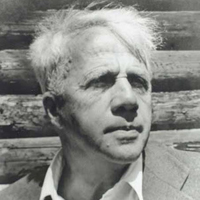The Road Not Taken by Robert Frost: Summary and Analysis
The Road Not Taken is a poem by four Pulitzer Prize winner American poet Robert Frost, published in 1916 as the first poem in the collection 'Mountain Interval'. Together with 'Stopping by Woods on a Snowy Evening', this poem 'The Road Not Taken' is one of the most anthologized, beloved and frequently studied poem in different levels in literature classes. This poem has four stanzas of five lines with a rhyming scheme abaab.

Robert Frost (1874-1963)
The speaker happens to meet a junction in the road while walking through a yellow woods. Two roads went in two different directions in a pale forest, and the poet felt sorry that he could not take both the roads being one traveler. For a long time he stood there and watched one of them, as far as he could, to the farther end where it took a curve towards the brushwood.
Then the poet took the other road, which was equally fair and clean, and which had perhaps a better claim, since it was covered with grass and lacked foot-mark. Although, keeping that thing apart, both the roads were almost identical, for both were equally trodden. And both the roads that day looked fresh and untrodden, for the leaves of grass were standing erect. The poet sadly chose the second one and kept the first one reserved for some other day. Yet he knew that one road leads mysteriously to another, and, therefore, he was not sure if he would return to travel the other road or not.
The poet says that he will go on telling this incident with a sense of sadness in the times to come. The speaker ends on a nostalgic note, and wonders how different things would have been if he had chosen the other path.
The poem is movingly lyrical and symbolically rich and one of most cherished poem. The road mentioned in this poem is actual and figurative. This poem is representative of the journey of life and many options that we face throughout our life where we have to make choices one over another. And later in life we wonder how would have been our life had we taken the not chosen road. Everyone has to face the situation of dilemma and a point where the decision becomes harder to take. But as none can take two roads at the same time, one has to make an option and move ahead. We are led to one direction only and we cannot come back to the same point again to make another decision. The chosen road ends up making significant change in our life and we have a curiosity of the road not taken.
The poem is misinterpreted and a bit tricky. Many interpretations refer to the importance of not choosing the most taken road while it is about the regret we make over the past decisions. It is human nature to look back and blame for the minor incidents of life. But it is also true that whichever road we may take or decisions we make, we encounter some mishaps and meet some pleasant surprises. Meanwhile, we miss something good on the other path.
It contains the element of hesitation, of indecision about what road to take. The hesitation of a strong but humble man, a man who pauses before he makes a decision not because he is timid, but simply because he is accustomed to weighing and considering all his choices, even the simplest ones.
The poem is "an indication of Frost's increasing versatility" (Thompson). With dramatic irony, the soliloquizing speaker is permitted to characterize himself, of course unintentionally, as one who habitually wastes energy in regretting any choice made: belatedly but sadly he sighs over the attractive alternative rejected. The prime theme of the poem is to choose between two paths without having any knowledge of where each road will lead.
Cite this Page!
Shrestha, Roma. "The Road Not Taken by Robert Frost: Summary and Analysis." BachelorandMaster, 15 Oct. 2017, bachelorandmaster.com/britishandamericanpoetry/the-road-not-taken-summary-and-analysis.html.
Related Topics
The Silken Tent: Summary and Analysis
The Death of the Hired Man: Summary and Analysis
Neither Out Far nor In Deep: Summary and Analysis
West Running Brook: Summary and Analysis
Stopping by Woods on a Snowy Evening: Analysis
A Considerable Speck: Critical Analysis
Mending Wall: Summary and Analysis
Home Burial: Summary and Analysis
After Apple Picking: Summary and Analysis
Fire and Ice: Summary and Analysis
Nothing Gold Can Stay: Summary and Analysis
Acquainted with the Night: Summary and Analysis
The Gift Outright: Summary and Analysis
 |
bachelorandmaster.com |